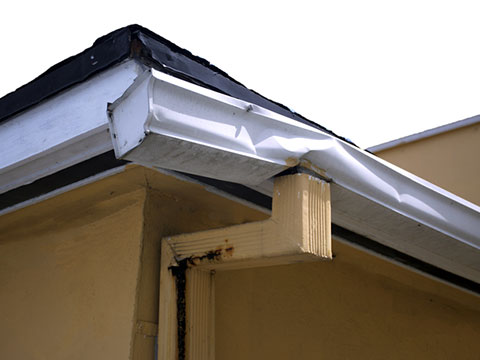Gutters may not be the most glamorous part of your home, but they play a critical role in protecting it from water damage. When they’re working properly, gutters divert rainwater away from your roof, siding, foundation, and landscaping. But when they’re damaged or clogged, trouble isn’t far behind.
Here’s how to identify common gutter issues—and what to do once you spot them.
1. Signs Your Gutters Are in Trouble
Not sure whether your gutters are in good shape? Watch for these telltale warning signs:
Visible Cracks or Holes
Small cracks might seem harmless, but over time they grow and allow water to leak. This can lead to wood rot, mold, and structural issues.
Sagging or Pulling Away
If sections of your gutter are bowing or detaching from the fascia board, they’re likely weighed down by debris or water—or the brackets have loosened.
Water Damage or Stains
Look for dark streaks or watermarks on your siding, fascia, or near the foundation. These usually indicate that water is overflowing or leaking from your gutters.
Pooling Water or Erosion
After a rainstorm, check the ground around your home. Pools of water or eroded soil suggest poor water drainage, often caused by faulty or blocked gutters.
Rust and Corrosion
Metal gutters are susceptible to rust over time, especially if water is sitting in them too long. Rust is a sign it’s time to consider repair or replacement.
Peeling Paint or Mildew
Peeling exterior paint or mildew growth on or near your gutters can be a result of moisture that’s not being properly directed away.
2. What to Do Once You Spot Gutter Damage
Inspect Thoroughly
Once you see signs of damage, perform a full inspection of your gutter system—ideally on a dry day. Check all sections, including joints and downspouts.
Clean Out Debris
Before repairing anything, clean the gutters thoroughly to remove leaves, dirt, and standing water. This helps you identify the exact source and extent of the damage.
Seal Small Leaks
Use waterproof gutter sealant or roofing cement to patch small holes or cracks. Make sure the area is dry before applying.
Replace or Reinforce Hardware
Tighten loose screws or brackets. If the gutter is sagging, add new hangers to provide more support.
Replace Damaged Sections
If a section is too damaged to repair (e.g., it’s rusted through or broken), it’s best to replace it entirely. Match the material and size for a seamless fit.
Check the Slope
Gutters should have a slight slope (about 1/4 inch every 10 feet) toward the downspout. Use a level to make sure water is flowing properly and not pooling.
3. When to Call a Professional
If the damage is widespread, your gutters are difficult to access, or you’re unsure about repairs, bring in a pro. Gutter repair and replacement specialists can assess the condition, recommend solutions, and ensure your system works efficiently—saving you from future headaches.
Final Thoughts
Gutter damage can sneak up on you, but regular inspections and maintenance make all the difference. By catching problems early and knowing what steps to take, you can protect your home from costly water damage and keep your gutters functioning for years to come.
We offer free quotes so don’t hesitate to give us a call. We are here to help!

